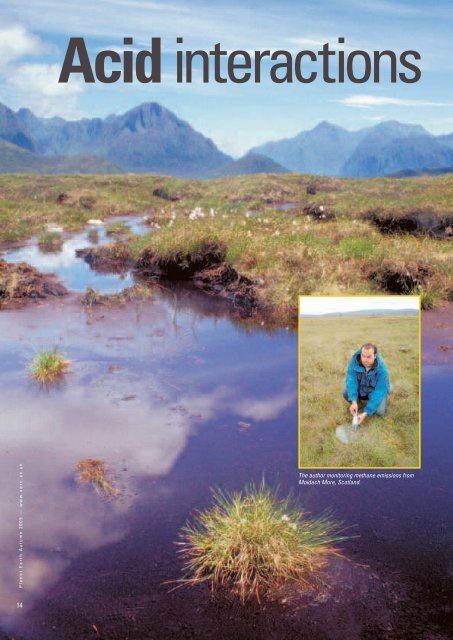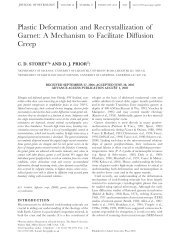+ view PDF of Gauci 2005 - The Open University
+ view PDF of Gauci 2005 - The Open University
+ view PDF of Gauci 2005 - The Open University
You also want an ePaper? Increase the reach of your titles
YUMPU automatically turns print PDFs into web optimized ePapers that Google loves.
Planet Earth Autumn <strong>2005</strong> — www.nerc.ac.uk<br />
14<br />
Acid interactions<br />
<strong>The</strong> author monitoring methane emissions from<br />
Moidach More, Scotland.
Fergus Mackay/Alamy<br />
Vincent <strong>Gauci</strong> explains how wetlands, acid rain and volcanoes interact to<br />
affect our climate.<br />
Pollution is a ‘bad thing’ right? If only things were that<br />
simple! New research suggests acid rain falling on wetlands<br />
could be helping to keep greenhouse gases in check.<br />
Earth’s wetlands store vast amounts <strong>of</strong> carbon. Water-loving<br />
plants like sphagnum mosses photosynthesise, turning carbon<br />
dioxide into plant material that builds up soggy, carbon-rich soils<br />
over thousands <strong>of</strong> years. In peatlands—just one form <strong>of</strong> wetland<br />
—there’s as much carbon locked away in the soil as is contained<br />
in the atmosphere. Carbon dioxide isn’t the only gas that moves<br />
between wetlands and the atmosphere. <strong>The</strong>se ecosystems emit<br />
vast quantities <strong>of</strong> methane, a greenhouse gas that, molecule for<br />
molecule, is about 20 times more powerful than carbon dioxide.<br />
Microbes called methanogens, which thrive in waterlogged and<br />
oxygen-free conditions, produce methane. Wetlands are the<br />
largest global source <strong>of</strong> the gas.<br />
<strong>The</strong>re are wetlands in Europe and the United States, but<br />
most are found in remote areas <strong>of</strong> the world such as Siberia and<br />
northern Canada, and in the tropics, for example Indonesia and<br />
the Pantanal in South America. At the <strong>Open</strong> <strong>University</strong>, we<br />
realised that although most wetlands are<br />
far from big industrial centres, some <strong>of</strong><br />
these important ecosystems could still be<br />
susceptible to atmospheric pollution.<br />
Could pollution affect the amount <strong>of</strong><br />
methane wetlands emit?<br />
We decided to investigate the sulphur<br />
pollution that is found in acid rain. Many<br />
countries, particularly in Western Europe<br />
and North America, have taken great<br />
strides to reduce this problem since the<br />
1980s. But globally, the problem continues to grow, roughly<br />
keeping pace with the economic<br />
growth <strong>of</strong> Asia. Volcanoes are also important sources <strong>of</strong> sulphur,<br />
and over the Earth’s history they have been the main ‘polluters’.<br />
For example, the Icelandic Laki eruption <strong>of</strong> 1783-84 emitted as<br />
much sulphur as Western Europe’s industry would over ten years.<br />
In Moidach More, a peat bog in north-east Scotland, my<br />
colleagues (Nancy Dise, now at Manchester Metropolitan<br />
<strong>University</strong>, and David Fowler <strong>of</strong> the Centre for Ecology &<br />
Hydrology, Edinburgh) and I simulated the sulphate deposition<br />
that acid rain still brings to polluted parts <strong>of</strong> the world. <strong>The</strong><br />
experiment also simulated the amount and timing <strong>of</strong> acid rain<br />
that would have come from the Laki eruption. Our monitoring<br />
showed that the pollution actually reduced methane emissions by<br />
30-40%. <strong>The</strong> reason for this is that the sulphate component <strong>of</strong><br />
acid rain pollution sparks a battle between different microbial<br />
populations that live in the peat. Most peatland organisms get<br />
their nutrients from elements dissolved in rain and snow – and<br />
normally there’s very little sulphate. Under these conditions,<br />
methane production is the last step as plant matter decomposes.<br />
But even the very small amounts <strong>of</strong> sulphate in acid rain can<br />
shift the balance <strong>of</strong> microbial power. A different set <strong>of</strong> microbes,<br />
<strong>The</strong> Laki eruption emitted<br />
as much sulphur as<br />
Western Europe’s<br />
industry would over<br />
ten years.<br />
called sulphate-reducing bacteria, now succeeds in the battle for<br />
limited food sources within the peat. <strong>The</strong>y out-compete the<br />
methanogens, leaving them without much food, so less methane<br />
is produced.<br />
It’s one thing to find out that simulated acid rain can reduce<br />
emissions from a single peat bog experiment, but quite another<br />
to find out whether or not the interaction is important globally.<br />
So with colleagues at the NASA Goddard Institute for Space<br />
Studies (GISS), we drew together the results <strong>of</strong> similar<br />
experiments in Sweden and North America. With the help <strong>of</strong> a<br />
global wetland methane emission model, and estimates <strong>of</strong><br />
sulphur deposition from our colleagues’ model <strong>of</strong> the world’s<br />
atmosphere, we were able to make an estimate at the global scale.<br />
<strong>The</strong> results surprised us. Without the effect <strong>of</strong> sulphur from<br />
industrial sources, wetlands would become an increasingly large<br />
source <strong>of</strong> methane as climate warms. This is because more<br />
methane is produced as temperatures rise. But when we included<br />
acid rain in our model, we found that sulphate pollution <strong>of</strong>fsets<br />
the effect <strong>of</strong> warmer temperatures, bringing global methane<br />
emissions from wetlands down to pre-<br />
industrial levels.<br />
Intriguing questions arose from this<br />
work: What would happen if you solved<br />
the acid rain problem in Asia? Would<br />
methanogens in wetlands, suddenly<br />
relieved <strong>of</strong> sulphate input from acid rain,<br />
immediately fight back against the<br />
competitive sulphate-reducing bacteria?<br />
How would wetland ecosystems respond<br />
to a single large pulse <strong>of</strong> acid rain like the<br />
fallout from the Laki eruption?<br />
To try to answer these questions, we went back to Moidach<br />
More in 2000 and 2003 with <strong>Open</strong> <strong>University</strong> volcanologist<br />
Steve Blake. We found that wetlands are slow to return to<br />
business-as-usual methane emission rates (and the modelling<br />
work had also suggested the acid rain effect should continue well<br />
into the middle <strong>of</strong> the 21st century). Sulphur fallout from a<br />
Laki-like eruption should suppress methane emissions for five to<br />
ten years after the end <strong>of</strong> the eruption—much longer than the<br />
two or so years during which volcanic aerosols might affect the<br />
atmosphere.<br />
Many wetlands are near active volcanoes, or in the path <strong>of</strong><br />
volcanic fallout (like wetland-rich Siberia in the path <strong>of</strong> Icelandic<br />
eruption fallout). So over geological time scales volcanoes may<br />
play a crucial role in controlling how much methane wetlands<br />
release. Deeper in geological time, around 50 million years ago<br />
during the early Eocene, wetland methane emissions may even<br />
have been the main driver behind the warm climate <strong>of</strong> the day.<br />
Large, Laki-like eruptions during that time could, by stimulating<br />
battles between bugs in bogs, have resulted in significant changes<br />
to Earth’s climate.<br />
Vincent <strong>Gauci</strong> is a lecturer in Earth systems and ecosystems science, at the Centre for Earth, Planetary, Space and Astronomical Research (CEPSAR),<br />
<strong>The</strong> <strong>Open</strong> <strong>University</strong>, Walton Hall, Milton Keynes MK7 6AA, tel: 01908 85 8137, email: V.<strong>Gauci</strong>@open.ac.uk, http://cepsar.open.ac.uk/pers/v.gauci/<br />
Planet Earth Autumn <strong>2005</strong> — www.nerc.ac.uk<br />
15



